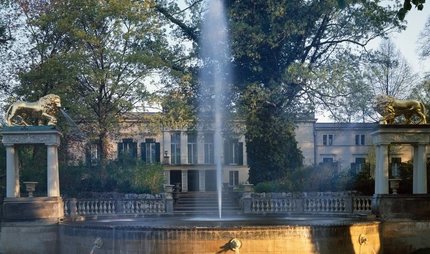
Heilandskirche Sacrow
Like a ship in the harbour
The romantic Heilandskirche is directly on a lakeside cove and offers a magical view.
The Heilandskirche (Church of the Redeemer) in Sacrow lies quietly and dreamily on the lakeside shore. Built in the Italianate style with a separate bell tower and located directly on Jungfernsee, the little church has a Mediterranean charm that is sure to charm you.
The architecture of the Heilandskirche
Friedrich Wilhelm IV himself provided the original sketches and drafts for a small church with a campanile – a separate bell tower – in the architectural style that was common in Italy, but not in Prussia. His favourite architect Ludwig Persius was commissioned to design the church in 1844. It is close to the manor house known as Sacrower Schloss, in a park designed by Peter Joseph Lenné. The park belongs to the UNESCO world heritage site known as the Palaces and Parks of Berlin and Potsdam.
The church is designed to look like a ship at anchor, and is inspired by early Christian religious buildings. It has a shallow roof and gives the impression of a three-aisled basilica. The building is made of yellow brick, decorated with blue tiles. An arcade runs along the sides of the church facing the lake and offers wonderful views across the water. Inside, there is an eye-catching fresco in the Byzantine style. The campanile is made of the same yellow brick as the church, and has a plaque commemorating the fact that in 1897 it was used as an antenna for the first wireless telegraph transmission in Germany.
The Heilandskirche in the GDR
For many years, the church was in a state of limbo, because the border to West Berlin ran right through it. Trapped in no-man’s land, it was left to decay. The congregation celebrated its last Christmas service in 1961, after which it was vandalised by East German border guards and sealed off to prevent anyone from escaping across the site. The guards even reinforced the campanile with concrete slabs and used it as a watchtower. West Berliners were forced to put up with the sight of its increasing dilapidation until 1984/85, when the mayor of West Berlin, Richard von Weizsäcker, finally persuaded the East German authorities to at least restore the façades.
The Heilandskirche today
On Christmas Eve 1989, just after the fall of the Berlin Wall, the congregation once again celebrated a service in the still-ruined church. Extensive restoration began in 1993, and today there are services and concerts at this romantic jewel of a church, as well as weddings, where the bride can arrive by boat.



